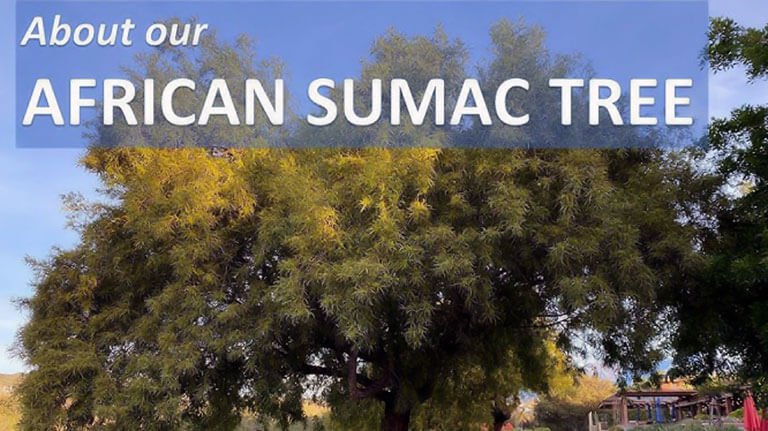African Sumac Tree Problems: Key Issues & Solutions
African Sumac trees can face issues like invasive growth, leaf spots, and pest infestations. Regular pruning and treatment can help manage these problems effectively.
The African Sumac tree, known for its lush foliage and resilience, can be a beautiful addition to any landscape. However, it is not without its challenges. Gardeners often encounter problems such as overgrowth, which can crowd other plants, and various pests that may target the tree.
Leaf spots can also emerge, affecting its overall health. Understanding these common issues is essential for maintaining a vibrant and thriving African Sumac. Proper care, including regular pruning and pest management, ensures this tree remains a stunning focal point in your garden while preventing potential damage. Embrace the beauty of the African Sumac while staying vigilant against its common problems.
Introduction To African Sumac Trees

The African Sumac tree, also known as Rhus lancea, is a unique plant. It thrives in various climates and offers many benefits. Understanding its native habitat and characteristics helps prevent common issues. This tree is popular for landscaping and provides aesthetic value.
Native Habitat And Characteristics
African Sumac trees are native to southern Africa. They grow well in dry and semi-arid regions. Here are some key characteristics:
- Height: Can reach up to 30 feet tall.
- Spread: Can spread 20 feet wide.
- Leaves: Green, glossy, and compound in structure.
- Flowers: Small, yellow-green clusters appear in summer.
- Fruit: Small, red berries that attract birds.
This tree is drought-resistant and survives in poor soil. Its adaptable nature makes it a favorite for many gardeners.
Popularity And Uses
African Sumac trees are popular in landscaping. They are often used for:
- Shade in gardens and parks.
- Windbreaks in open areas.
- Soil stabilization on slopes.
- Wildlife habitats due to their berries.
They are easy to maintain. Their resilience makes them ideal for many landscapes. Homeowners appreciate their beauty and versatility.
Understanding these aspects helps in caring for African Sumac trees. Proper knowledge prevents potential problems and enhances growth.
Common Health Issues In African Sumac Trees
African Sumac trees are resilient but face several health problems. These issues can affect their growth and appearance. Recognizing these problems early helps in maintaining a healthy tree.
Pest Infestations
Pests can harm African Sumac trees. Common pests include:
- Scale insects: They suck sap and weaken the tree.
- Aphids: These tiny bugs also feed on sap.
- Spider mites: They create webs and cause leaf damage.
Signs of pest infestations include:
- Yellowing leaves
- Stunted growth
- Visible bugs on leaves
Control methods include:
- Insecticidal soap
- Neem oil
- Regular monitoring
Disease Threats
African Sumac trees can suffer from various diseases. Common diseases include:
| Disease | Symptoms | Control Methods |
|---|---|---|
| Root rot | Wilting leaves, stunted growth | Improve drainage, avoid overwatering |
| Leaf spot | Brown spots on leaves | Remove affected leaves, use fungicides |
| Powdery mildew | White powdery substance on leaves | Improve air circulation, fungicides |
Monitor trees regularly for symptoms. Early detection is key to successful treatment. Implement control methods promptly to ensure the health of your African Sumac trees.
Environmental Stress Factors
The African Sumac tree faces various environmental stress factors. These factors can significantly impact its health and growth. Understanding these challenges helps in effective tree care.
Drought Stress
Drought stress occurs when the tree lacks water. This condition can weaken the tree. Signs of drought stress include:
- Wilting leaves
- Leaf drop
- Stunted growth
To mitigate drought stress:
- Water the tree deeply and regularly.
- Apply mulch around the base to retain moisture.
- Monitor weather conditions and adjust watering accordingly.
Excessive Water Stress
Excessive water stress happens with too much moisture. This can lead to root rot and other diseases. Symptoms of excessive water stress include:
- Yellowing leaves
- Mushy roots
- Fungal growth at the base
To address excessive water stress:
- Ensure proper drainage in the planting area.
- Avoid overwatering, especially after heavy rains.
- Check soil moisture levels regularly.
By recognizing these stress factors, tree owners can take action to protect their African Sumac trees.
Soil And Nutrient-related Problems
The health of the African Sumac tree relies heavily on soil and nutrients. Poor soil conditions and nutrient deficiencies can lead to serious issues. Understanding these problems helps in maintaining a healthy tree.
Poor Soil Conditions
Poor soil conditions can affect the growth of African Sumac trees. Here are some common issues:
- Compacted Soil: Makes it hard for roots to grow.
- Poor Drainage: Leads to waterlogged soil, harming roots.
- Soil pH: Affects nutrient availability for the tree.
Check the soil texture. Loamy soil is best for growth. Sandy or clay soils can cause problems.
Nutrient Deficiencies
Nutrient deficiencies can weaken the African Sumac tree. Here are key nutrients:
| Nutrient | Symptoms of Deficiency |
|---|---|
| Nitrogen | Yellowing leaves and stunted growth. |
| Iron | Chlorosis or yellowing between leaf veins. |
| Potassium | Brown leaf edges and poor fruit development. |
Regular soil testing can help identify deficiencies. Fertilizing the soil can restore nutrients. Use organic fertilizers for a balanced approach.
Physical Damage And Its Impacts
The African Sumac Tree faces various physical damage issues. These problems can hinder its growth and overall health. Understanding these issues helps in proper care and maintenance.
Mechanical Injuries
Mechanical injuries occur from human activities or equipment. These injuries can cause significant damage to the tree.
- Trimming mistakes: Incorrect pruning leads to open wounds.
- Equipment damage: Lawn mowers and trimmers can harm bark.
- Construction activities: Heavy machinery can compact soil around roots.
Such injuries may lead to:
- Increased susceptibility to pests
- Infection from fungi or bacteria
- Stunted growth
Effects Of Severe Weather
Severe weather can severely impact the African Sumac Tree. Strong winds, heavy rain, and extreme temperatures pose risks.
| Weather Condition | Impact |
|---|---|
| High winds | Branches may break or the tree may topple. |
| Heavy rainfall | Root rot can occur from excessive moisture. |
| Frost | New growth may be damaged or killed. |
Understanding these impacts aids in taking protective measures. Proper care can help mitigate these issues.
Management Strategies For Healthy Trees
Keeping your African Sumac tree healthy requires careful management. Healthy trees resist pests and diseases better. Implementing the right strategies ensures vibrant growth.
Proper Planting Techniques
Planting your African Sumac tree correctly sets a strong foundation. Follow these steps:
- Choose the right location: Select a spot with full sunlight.
- Prepare the soil: Use well-draining soil rich in nutrients.
- Dig the hole: Make it twice the width and the same depth as the root ball.
- Position the tree: Place it straight and fill in the soil gently.
- Water thoroughly: Ensure the roots get enough moisture.
Timely Pruning Practices
Regular pruning helps maintain shape and health. Follow these guidelines:
- Remove dead branches: This prevents disease spread.
- Thin crowded branches: Allow better air circulation.
- Shape the tree: Keep it balanced and attractive.
- Prune during dormancy: Late winter is ideal.
- Use clean tools: Prevent the introduction of pests.
By following these management strategies, you can enjoy a healthy African Sumac tree. A well-cared tree enhances your landscape.
Pest And Disease Control Solutions
Pest and disease control is vital for the health of the African Sumac tree. Proper management can prevent damage and promote growth. Several methods exist to tackle these issues effectively. Below are some effective solutions.
Biological Control Methods
Biological control uses natural predators to manage pests. This method is eco-friendly and safe for the environment.
- Ladybugs: They feed on aphids and mites.
- Parasitic Wasps: They target caterpillars and other harmful insects.
- Nematodes: These microscopic worms attack soil-borne pests.
Planting companion plants can also help. Consider planting:
- Marigolds: They repel aphids.
- Garlic: It deters various pests.
Chemical Treatments
Chemical treatments can be effective for severe infestations. Use them carefully to avoid harming beneficial insects.
| Pest | Chemical Treatment | Application Method |
|---|---|---|
| Aphids | Insecticidal soap | Spray on affected areas |
| Spider mites | Miticides | Apply with a fine mist |
| Fungal infections | Fungicides | Use as a soil drench |
Always read labels and follow instructions. Monitor the tree after treatment for any side effects.
Regular checks for pests and diseases can help. Quick action ensures the health of your African Sumac tree.
Preventive Measures And Best Practices
Taking care of your African Sumac tree is essential. Preventive measures can save you from many problems. Follow best practices for a healthy tree.
Regular Monitoring And Maintenance
Regular checks help catch issues early. Here are some tips:
- Inspect leaves for discoloration or spots.
- Check for pests like aphids or spider mites.
- Look for signs of diseases such as powdery mildew.
Set a schedule for monitoring:
| Task | Frequency |
|---|---|
| Leaf Inspection | Weekly |
| Soil Check | Monthly |
| Pest Control | As Needed |
Trim dead branches to promote growth. Water the tree during dry spells. Always ensure it has enough sunlight.
Adopting Sustainable Gardening Practices
Sustainable practices benefit the tree and the environment. Here are ways to implement them:
- Use organic fertilizers to enrich the soil.
- Plant native species nearby to attract beneficial insects.
- Practice mulching to retain soil moisture.
Follow these steps:
- Choose eco-friendly products.
- Rotate plants annually to prevent soil depletion.
- Use rainwater for irrigation.
These methods will keep your African Sumac tree healthy. Enjoy a thriving garden with minimal problems.
Frequently Asked Questions
What Are Common African Sumac Tree Issues?
Common issues include leaf spots, pests, and poor growth. Regular maintenance can help mitigate these problems.
How To Treat African Sumac Pests?
Use insecticidal soap or neem oil to effectively manage pests like aphids and scale insects on African Sumac trees.
Why Are My African Sumac Leaves Turning Yellow?
Yellowing leaves often indicate overwatering or nutrient deficiency. Check soil moisture and consider fertilizing for better health.
What Diseases Affect African Sumac Trees?
Diseases like root rot and powdery mildew can affect African Sumac. Proper drainage and airflow help prevent these issues.
How To Improve African Sumac Growth?
Ensure well-drained soil, adequate sunlight, and regular watering. Fertilizing in spring also promotes stronger growth.
Conclusion
Addressing African Sumac tree problems is essential for maintaining a healthy landscape. Regular inspections can help identify issues early. Proper care, including suitable pruning and pest control, promotes vitality. By being proactive, you can enjoy the beauty of these trees while minimizing potential challenges.
Keep your garden thriving with informed care strategies.






